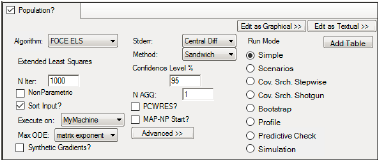Hi,
My colleagues and I were having a discussion on calculations regarding the omega and omegastderr output and getting this into useful terms that can help you better understand the variability for the purposes of reporting. We are hoping experts in the extranet community could help to clarify.
I know that the output on the omega block generates a variance.
For proportional/exponential error models
CV=sqrt(omega)*100
For additive error models
SD=sqrt(omega)
Are these conventions correct dependent the error model structure you select?
For the omegastderr, how does this term relate to the final parameter estimate? What math is involved to get this into an %RSE term?
To our understanding, for a given parameter
%RSE=(Omegastderr)/SQRT(Omega)*100
Is this correct? From what I can tell this is different than the calculation that is done with NONMEM output. Any insight would be greatly appreciated.
Lance
- Micaela Reddy, Albertsnarm, Natalinak and 132 others like this


 Posted by
Posted by 


 Posted by
Posted by 
